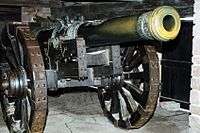Falconet (cannon)
| Part of a series on |
| Cannon |
|---|
 |
| History |
| Operation |
| By country |
| By type |

The falconet or falcon was a light cannon developed in the late 15th century. During the Middle Ages guns were decorated with engravings of reptiles, birds or beasts depending on their size. For example, a culverin would often feature snakes, as the handles on the early cannons were often decorated to resemble serpents. The falconet fired small yet lethal shot of similar weight and size to a bird of prey, and so was decorated with a falcon. Similarly, the musket was associated with the sparrowhawk.[1]
Its barrel was approximately 4 feet (1.2 m) long, had a caliber of 2 inches (5 cm)[2] and weighed 80 kilograms (176 lb)~200 kilograms (441 lb). The falconet used 0.5 pounds (0.23 kg) of black powder to fire a 1 pound (0.5 kg) round shot approximately 5,000 feet (1,524 m).[3][4] They could also be used to fire grapeshot.
The falconet resembled an oversized matchlock musket with two wheels attached to improve mobility.[5] In 1620s Germany a breechloading version was invented, seeing action in the Thirty Years War.[6] Many falconets were in use during the English Civil War[4] as they were lighter and cheaper than the culverins, sakers and minions. During times of unrest they were used by the nobility to defend their grand houses.[7]
Though developed for use on land, the falconet gained naval prominence during the 17th century for the defence of light vessels; for example, on small boats for boarding manoeuvres. They were heavily used in the American Revolutionary War by both the British and the Colonists.
Further reading
References
- ↑ http://www.regimental-art.com/history_greys.htm
- ↑ http://www.probertencyclopaedia.com/cgi-bin/res.pl?keyword=Falconet&offset=0
- ↑ Artillery through the ages
- 1 2 English ordnance 1626 to 1643
- ↑ http://farm1.static.flickr.com/65/213116082_cb5a56c5e6.jpg?v=0
- ↑ http://www.gunbroker.com/Auction/ViewItem.asp?Item=104992224
- ↑ http://www.stephenwoodresearch.com/port/mil01.htm